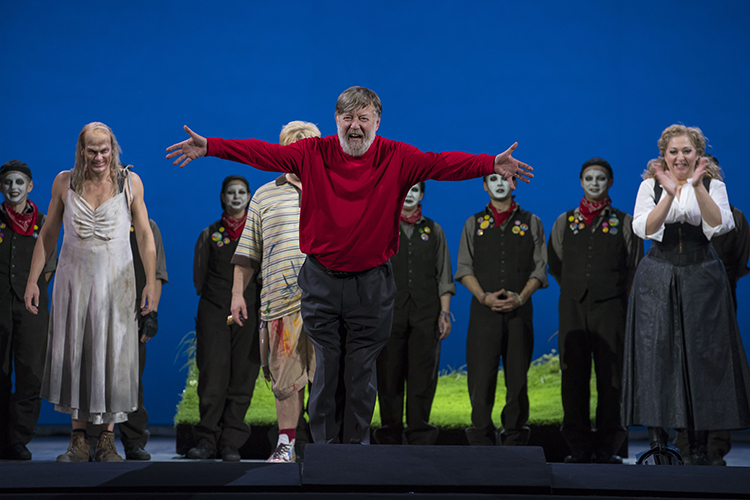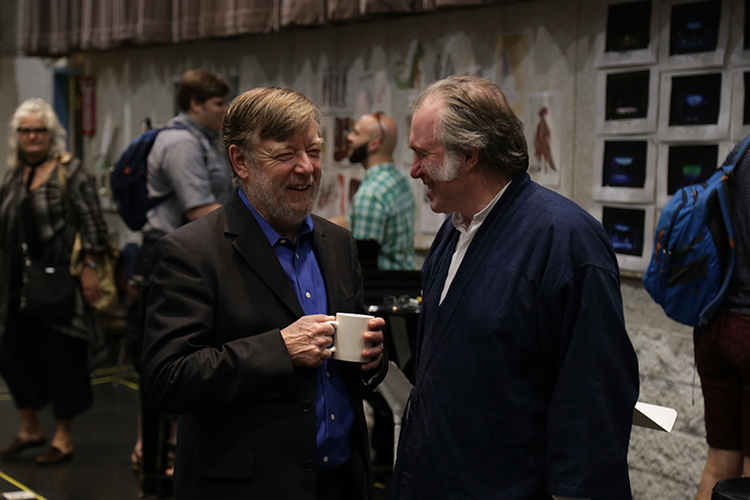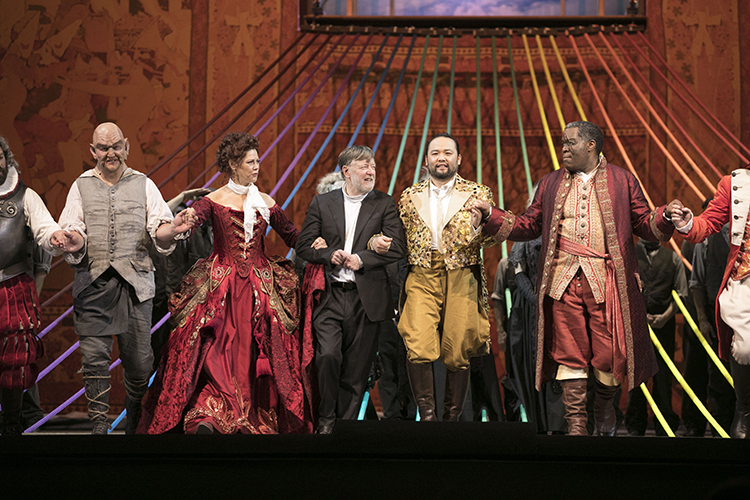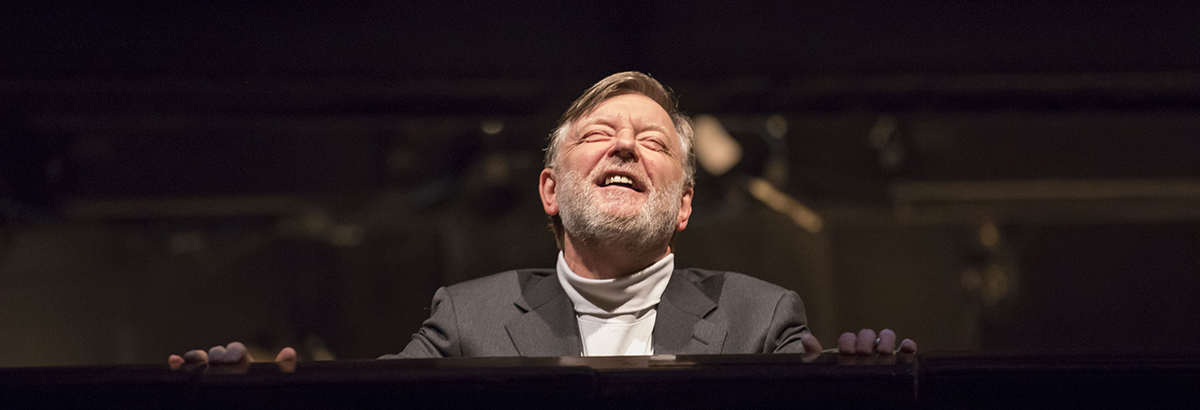April 07, 2020
Conducting the RING
Talking with Lyric music director Sir Andrew Davis
Sir Andrew Davis came to Wagner’s music comparatively late. The first time he felt overwhelmed by it was during a performance of Die Meistersinger von Nürnberg in the mid-1980s, after having been a conductor for more than 15 years. “I’d never been to a Ring cycle,” he recalls, “and I didn’t go to Bayreuth until 2001, the year before I conducted there!”

The prospect of leading a Ring was a major factor in Davis’s agreeing to come to Lyric as music director. By the time he began his tenure (2000/01), he was enormously eager to tackle the Wagner operas. The Flying Dutchman came in that first season, with Parsifal the following year (reprised in 2013/14), then the individual Ring operas (Die Walküre in 2002/03, Siegfried in 2003/04, separate performances of both Das Rheingold and Götterdämmerung followed by three full Ring cycles in 2004/05), and Tristan und Isolde (2008/09). He conducted the first three operas in the current new Ring production individually during three
consecutive seasons, beginning in 2016/17.
In building up the stamina for conducting his first Ring, Sir Andrew found it helpful to have previously led Parsifal, another very lengthy work (and also Davis’s favorite Wagner opera). Although Das Rheingold is two-and-a-half hours sans intermission, he confesses that “I’ve never felt it to be that long.” Götterdämmerung is five-and-a-half hours, “but because Siegfried turns on a dime much more than Götterdämmerung does, to me it’s the trickiest, the most physically draining. Building its architecture is the biggest challenge.”
Davis started preparing his first Ring several years ahead. “From the time I began here [as music director], I was already working on it – you can’t just open the score and conduct it! When I’d have some time when I was free or doing something that was relatively less taxing, I’d go back to it constantly.” Although, in creating the overall shape of his Ring interpretation, “it might have been better to begin with Rheingold, it didn’t really bother me. It was good to have Walküre and Siegfried under my belt, before getting to operas 1 and 4 and then the whole cycle. Given the proportions of this piece, you don’t come to your final view of it until you actually do it. You have a conception in your mind, and then that gets modified in rehearsal.”

In anything Davis conducts, “I’ve never come to a conclusion – if you can call it that – about how a piece goes, until I’ve rehearsed it and am performing it. I’ve always tried to do my homework on an intellectual level, looking at how the structure works, but when push comes to shove, I do a lot of things by instinct. I can’t emphasize that enough – you can do it that way if you have an overall concept of how things go.”
Wagner’s leitmotifs (signature themes) are crucial everywhere in the Ring, and one mistake Davis found some conductors made in working with them was that “they’d always do them in the same tempo. Different motifs occurring at different tempi have everything to do with what’s happening dramatically and psychologically. The Fate motif, for example, can be slow and deliberate or impulsive – it depends on the situation. That can make the whole motif system more expressive, because the motifs recur in different contexts and different dynamic levels and speeds.” Expressiveness is everything in making music, but especially in Wagner. If one takes note of everything Wagner marks in the score, “there are so many places where there’sa tempo transition – he uses the word ‘allmählich,’ which means ‘gradually.’ The way you interpret that is crucial. Not to speak ill of colleagues, but sometimes when the word ‘langsamer’ [‘slower’] occurs, people forget that it’s ‘allmählich langsamer.’ Wagner is very specific. For instance, the ‘Todesverkündigung’ scene [Brünnhilde’s annunciation of death to Siegmund] can only work if you gradually move it. The points where you move it forward make the difference.”
Wagner’s instrumentation is pretty consistent from one Ring opera to another, even if “the sound picture one has in one’s head for Rheingold is that the orchestra is less dense than later. There’s a sort of starkness in moments of Rheingold that is more notable than in the others – the music for the giants, for example.” As for the writing for solo instruments, Davis enjoys passages that find “the oboe and clarinet taking over phrases from each other, which occurs throughout the Ring. The solo writing for horns is terrific as well, and I’m not just talking about Siegfried’s horn! Wagner was unique at the time in using the full extent of the horn’s virtuosity and emotional range.”
Wagner’s incomparable brilliance in writing for brass includes the trumpets. They’re often given the Sword (Nothung) motif, “but the context of the way that happens is enormously varied, whether extrovert or subtle. Actually, some of the most extraordinary writing is for the trombones, as in Wotan’s monologue in Walküre. A lot of that is long stretches where trombones have chordal progressions underneath.” Regarding solo strings, Davis especially relishes the cello solo in the first act of Walküre, “one of the greatest cello solos in the operatic or symphonic repertoire. And it’s accompanied by just the cello section – the only precedent for that is Rossini’s overture to William Tell! This music immediately reveals the depth of feeling that happens almost instantly, when Siegmund and Sieglinde encounter each other.”
The Ring begins underwater, with the conductor drawing sound as if from the bottom of the Rhine. How does one create that sense of submersion at the very start? “It’s hard! Especially for the horns, who all have the low E-flat. There’s a certain nervousness and responsibility in starting the whole thing off. At Lyric we’re fortunate to have an extraordinarily accomplished horn section, half of which doubles on the Wagner tubas. You feel the E-flat has been going on for five minutes before it actually starts! One should conduct it extremely calmly. In that whole opening sequence, you’re thinking about how to grade the crescendo. If you let it get too loud too soon, it doesn’t work.”
So much of Das Rheingold is simply conversation, supported and enhanced by the orchestra, “and there are large stretches where the orchestra isn’t used the same way as later in the cycle – it’s much drier. For example, there’s something very straightforward and direct about the giants: they want to be paid, they want Freia, and that’s it. Wagner is introducing a lot of characters and their relationships between each other, but in a much less complex fashion than happens later.”
Moving on to the great moments of Die Walküre, Davis thinks first of the Brünnhilde/Siegmund “Todesverkündigung” scene and the great monologue for Wotan (certainly the lengthiest solo passage in the Ring). Davis views the latter passage as “totally dependent on the singer. There can, of course, be a variety of interpretations, but everything must be totally tied to the text, and the way the singer underlines the subtleties of that text. Obviously, in rehearsal you have to achieve complete unanimity about the moments where you take time and the moments where you want the text to flow. In a way, that’s a passage where the conductor has least control. If it’s timed and colored intelligently by the singer, it doesn’t seem long at all.”
Sir Andrew Davis acknowledges the audience’s applause at the end of the dress rehearsal of Siegfried. There are massive climaxes in the music for all the principal characters in Walküre, and – as with so many other Wagner operas – balance is invariably an issue, despite the singer having the necessary vocal heft. “There are some moments in Wagner, as in Verdi and Strauss, where maybe for a moment the orchestra will come surging up more than you might think the composer should have done, but those moments are deliberate.” For example, Siegfried’s forging song, where “there’s a trick in finding the correct dynamic level while not losing the rhythmic intensity and strength of it. In all the Ring operas, you have to allow the singer and the text to be heard.”
The last act of Siegfried was composed after Wagner had given himself a 12-year hiatus from the Ring; he didn’t return to it until after he’d completed both Tristan and Meistersinger. What does Davis aim to show the audience, in terms of the steps forward that Wagner had taken musically? “If anything, I want to obscure the fact that the style changed. I don’t think by the end of Act Two you’re suddenly saying, ‘Ooh, this is different.’ But once you get into Act Three, there is a greater subtlety of orchestration. For the violins, for instance, suddenly it’s a good deal more difficult. Wagner is writing complex stuff at breakneck speed. The kind of outbreak after Siegfried says ‘Das ist kein Mann!’ [‘That is no man!’] is writing of a virtuosity that betrays the fact that he’d composed Tristan and Meistersinger. He now had a greater sense of how far he could push the orchestra.”
In Götterdämmerung, Davis appreciates the “long stretches where there’s a flow to the music – for example, moving from the Siegfried/Brünnhilde duet into the Rhine Journey. There’s also much less of the kind of quixotic virtuosity that you have to command in conducting Siegfried.”
Götterdämmerung starts with a murmur, not a bang, in the Norn scene, “where finding exactly the right tempo is important. If it’s too slow, it becomes static. There has to be a flow to it. At the same time, there must also be a sense that these are mythical beings, holding the fate of everything in their hands. There can never be a sense of haste. There’s something gnomic about their utterances, in a way. They’re not emotionally uninvolved – after all, they see the end of the world coming! So when they sink back down at the end of the scene, with a sense of foreboding and with their rope now broken, we know things aren’t going to turn out very well! There’s a certain despair to that opening scene that sets it apart, but then comes the sense of hope and renewal in the big celebratory love scene for Siegfried and Brünnhilde.” Everything flows beautifully through the opera’s three acts, “and then, at the end of the opera, the gods are gone and it’s just left up to us. That’s the implication.”
Do its varied challenges set Götterdämmerung apart from the other four operas? “In the culmination of the way Wagner uses leitmotifs, and just in terms of the orchestral writing – the complexity and subtlety of it – there’s definitely a huge difference from what has preceded it. Siegfried’s funeral music is unlike anything anyone had written before. Wagner’s choices in how he voices the brass section are so sophisticated. To me, there’s a consistent mastery of orchestration that is absolutely mind-boggling.”

Collaboration is everything in any Ring production, and Davis has truly rejoiced in the team assembled for this greatest of all operatic adventures. With Eric Owens, Christine Goerke, and all the other principals, “the whole feeling has been one of great collegiality and mutual respect.” Davis also greatly admires David Pountney's production, particularly "the way in which the sometimes startlingly different styles of individual acts are unified by the framework of the basic set design. He lets us into the secrets of how things work onstage. We see the mechanics – the way the Rhinemaidens and Valkyries fly through the air, and the constantly moving towers, for instance. This was a deliberate decision, and I think it’s worked brilliantly.” Above all, Davis is grateful that “for all David’s dramatic and visual ideas, he is one director who does start and end with the music. He knows it well and he has the deepest respect for it, so of course, that makes my life easier.”
Davis’s orchestra gets the last word, so to speak, in the Ring, with its seven-minute postlude following Brünnhilde’s “Immolation Scene.” In that music “the point is that the world will be redeemed by love. Wagner is actually optimistic, and seems to be saying, ‘The gods are gone and good riddance. Now human beings have to function without the gods’ influence or interference. As we find our own way, things have to be profoundly different.’ It’s moving to me that the fact that the last thing he says to us is essentially – to quote the Beatles – ‘Love is all you need.’ That’s what will save us.”
Edited from interviews with Roger Pines, Dramaturg, Lyric Opera of Chicago. This article was written for publication in the Ring cycle program, 2019/20 season.
Photos: Todd Rosenberg
